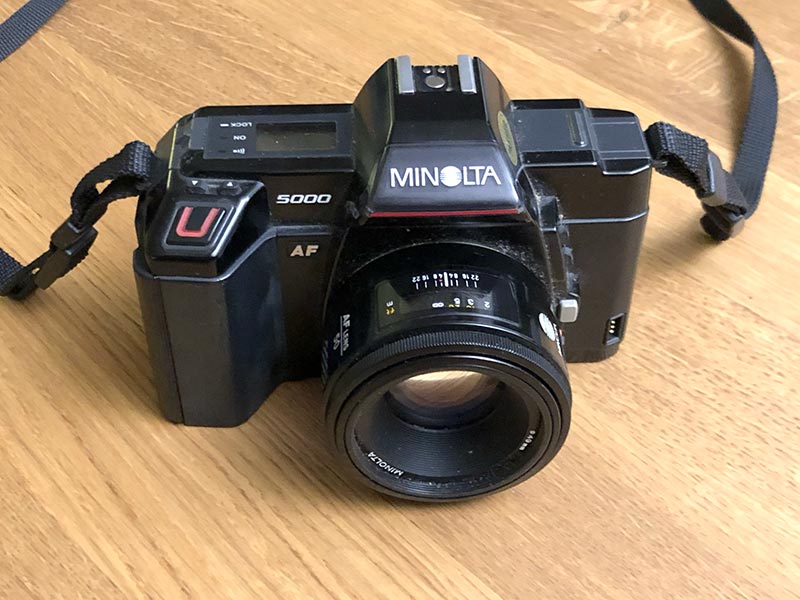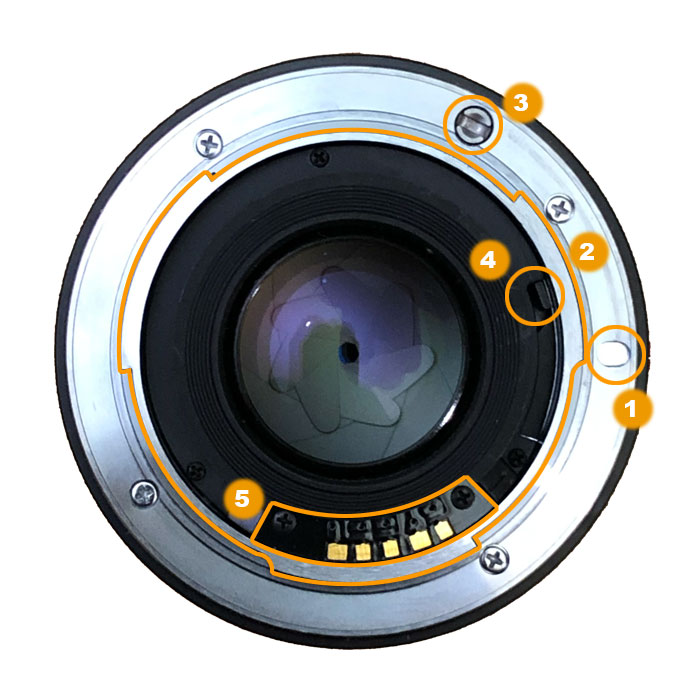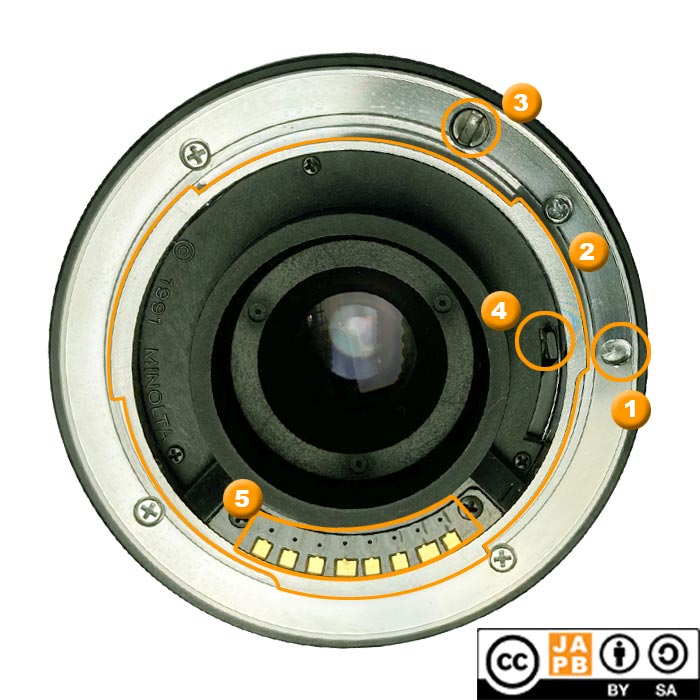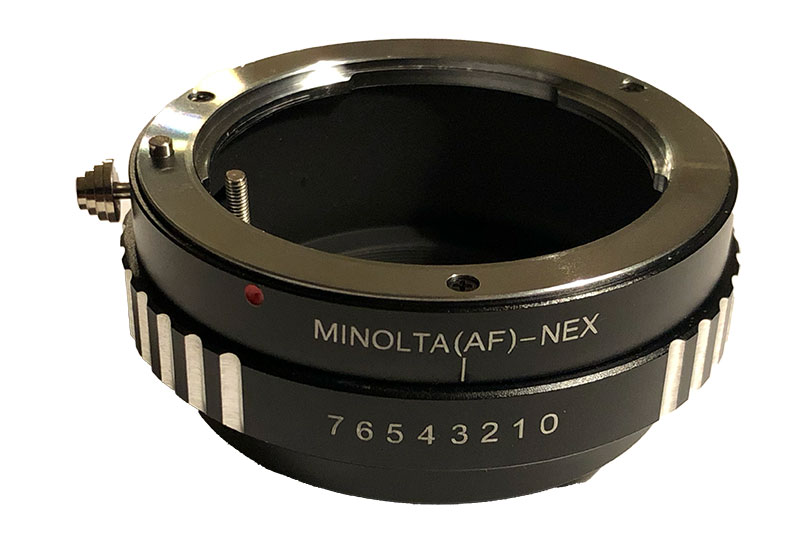Pekka Buttler (Updated 5/2025)
Please be advised: the Minolta A (also alpha or ⍺) mount is practically the same as the Sony A (also alpha or ⍺) mount, and while it would be most precise to constantly refer to the mount as the Minolta/Sony A (or Sony/Minolta A) mount, this article will simply refer to it as the Minolta A mount.
Minolta A mount specifications
Mount type: Bayonet (male-type)
Flange focal distance: 44,5 mm
Film format: 36mm x 24mm (‘Full frame’)
Mount communication (mechanical): aperture stop-down (camera-to-lens); slot-drive AF (camera-to-lens)
Mount communication (electronic): 5/8 electronic contacts (spring-loaded at the camera-end). Entire extent of communication (designed/implemented) unknown to JAPB
Basic Information on the Minolta A mount:
While several AF-contraptions had been attempted earlier (including Olympus OM-30, Pentax ME-F, Nikon F3AF, Canon T80 ), the real start of autofocus interchangeable lens cameras happened in 1985 in the form of the Minolta 7000 AF (Maxxum 7000 in North America; Alpha 7000 in Japan) and its attendant new lens mount.

Hence, the Minolta A mount is the world’s first lens mount geared towards autofocus, and – as such – deserves our attention. Moreover, the Minolta A mount served as the backbone of Minolta’s entire line of highly successful autofocus SLR cameras, was carried over into the digital age (on KonicaMinolta dSLR’s), survived KonicaMinolta’s camera business’ sale to Sony and while (as of 2024) Sony has discontinued all its A-mount camera models, it has technically not discontinued all the A-mount lenses1. As a result, the Minolta A mount offers a broad spectrum of lenses ranging from the 1980s into the 2020s.
A brief history of the Minolta A mount
Minolta’s 1985 launch of a functioning autofocus SLR was quickly followed in 1986–1987 by Nikon, Olympus, Pentax, Canon and Yashica. Importantly, as the Japanese camera giants went headlong into autofocus SLR’s, some of those manufacturers (Nikon, Pentax) did so within the confines of their existing SLR lens mount, while others introduced new mounts for their new marvels.
Minolta decided on a new mount that was not compatible with its existing Minolta SR mount. To add insult to injury – for those photographers who had a major investment into existing Minolta optics – the new Minolta A mount’s flange focal distance at 44,5 mm was just enough longer than that of the Minolta SR mount (43,5 mm) that adapting old, manual Minolta SR lenses on new Minolta AF bodies was difficult and necessitated bulky adapters fitted with corrective optics that not only led to a minor deterioration in image quality, but also changed the lens’s angles of view (acting as mild teleconverters). This development was not well-received by the Minolta faithful2.
Progression of the Minolta A mount …
With the Minolta A mount being in use for 39 years (and counting…), and considering the upheavals the SLR market has encountered during that time, it is no wonder that also the Minolta A mount has progressed (read: changed) a bit during that time. That said, those changes have been done while preserving backwards compatibility – even the oldest Minolta A lenses can be used on any newer body (film or digital). Even so, a short genealogy of the Minolta A mount is in order:
“Classic” and RS
(1985–>
These original Minolta AF lenses make up the foundation of the success of the Minolta A mount. Within three years from the system’s launch, Minolta had introduced a total of 33 Minolta AF lenses – ranging from a 16 mm fisheye to a 600 mm super tele. Many of these original lenses were subsequently re-introduced in RS (‘re-styled’) versions, and some are (in effect) still being sold as new, but under the Sony brand.

Key characteristics of the ‘classic’ and ‘RS’ Minolta A / Sony A mount:
[1] Locking groove at 3 o’clock.
[2] Three-pronged bayonet
[3] Slot-drive screw (only on ‘classic’ and ‘RS’ lenses)
[4] Aperture stop-down lever (on some lenses)
[5] 5 electronic contacts (spring-loaded at the camera end)
Other characterising features of Minolta A Classic and RS lenses (that are not visible on the mount)
• the lack of an aperture ring (aperture was controlled from the camera),
• a thin focus ring that – much like that of early AF Nikkor lenses – was barely usable (somewhat improved in the RS variants).
Xi
In what would turn out to be a somewhat failed bet, Minolta in 1991 introduced a series of cameras and lenses (referred to as xi according to the first camera, the Dynax 7xi) that offered ‘power zoom’ functionality (the lens’ zoom ring would not operate the zoom physically, but electronically (via a compatible body). To facilitate this added functionality another three electronic contacts were added to lenses and bodies. At the same time, focus rings (to facilitate manual focus) were done away with entirely. While Minolta introduced no further xi lenses after the first batch of xi zooms in 1991, subsequent generations of Minolta (and Sony) cameras continue to support these lenses.

Key characteristics of the Xi Minolta A / Sony A mount:
[1] Locking groove at 3 o’clock.
[2] Three-pronged bayonet
[3] Slot-drive screw
[4] Aperture stop-down lever (on some lenses)
[5] 8 electronic contacts (spring-loaded on the camera-end)
Further features not visible on the lens’ mount:
• the lack of an aperture ring (aperture was controlled from the camera),
• no focus ring,
• zoom ring that is inoperable unless mounted on a compatible camera that is switched on.
SSM/SAM
In an update consistent with the rest of the industry, Minolta started manufacturing lenses (and compatible bodies) that no longer relied on the bodies’ AF motors driving the lens through the slot-drive screw to facilitate autofocus. These new SSM/SAM lenses would use the three extra electronic contacts introduced with the xi bodies to feed power and control to a focusing motor situated within the lens.
SSM lenses used an ultrasonic-type motor and typically allowed full-time manual focus, while SAM type lenses used a micro motor that typically did not allow full-time manual focus.

Key characteristics of the SSM/SAM Minolta A / Sony A mount:
[1] Three-pronged bayonet (heavier/more premium lenses had a metal bayonet)
[2] Locking groove at 3 o’clock.
[3] 8 electronic contacts (spring-loaded on the camera-end)
[4] Aperture stop-down lever (on some lenses)
(No aperture ring on lens, and no slot-drive screw on mount)
DT
Alike all mainstream 35 mm camera manufacturers, also KonicaMinolta started by offering digital SLR’s that had digital sensors that did not cover the entire ‘full frame’. Instead, from the introduction of the KonicaMinolta 7D (2004) to the introduction of the Sony Alpha A900 (2008) all KonicaMinolta/Sony Digital SLR’s used a 1.5x crop factor (and the production of crop factor cameras did not end then). Alike the entire competition, also the Minolta A mount started featuring lenses tailor-made for crop factor sensors. These are (In KonicaMinolta/Sony jargon) known as DT lenses. DT lenses are invariably SSM/SAM lenses, hence:
All DT lenses are characterised by:
• the lack of an aperture ring (aperture was controlled from the camera),
• 8 electronic contacts in the mount (exact specifications unknown),
• an aperture stop-down lever,
• no slot-drive screw for body-operated autofocus (while some third party lenses may offer that also).
• Image circle is not designed to cover full frame (but may in some cases do so).
Adapting Minolta A lenses
Firstly, Minolta A lenses can still be used natively on all Sony dSLRs, and when doing so retain their full original functionality.
Having learned from the backlash Minolta suffered when orphaning their entire user base on introduction of the Minolta A mount, Sony has also introduced a broad range of Minolta A to Sony FE adapters. What is somewhat remarkable is that within that range of adapters there is also an adapter that allows using slot-drive autofocus lenses with full functionality. Hence, using Minolta A lenses while retaining full designed (still photography) functionality is possible using a suitable Sony adapter (see detailed compatibility on Sony’s site)
If you’re using a mirrorless camera that is not a Sony (or you simply do not feel that you need your lenses to autofocus), Minolta A lenses are also easily adapted using a regular adapter. However, because Minolta A lenses lack an aperture ring, you will need an adapter that is able to change the lens’ aperture by direct manipulation of the Minolta A lens’ aperture stop-down lever. One such adapter is pictured below.

Furthermore, Minolta A lenses can be adapted (albeit without autofocus or stop-down automation) to most other dSLR mounts (including Canon EF, Nikon F, and Pentax K) using an adapter that combines the ability to manipulate the lens’ aperture with optics to allow for infinity focus.
Read more:
Minolta A-mount lens database on Dyxum.com
Minolta A lens glossary on Dyxum.com